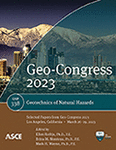Effect of MICP Treatment in Modulus Reduction and Damping Curves on Poorly Graded Sand and Nonlinear Site Response Analysis
Publication: Geo-Congress 2023
ABSTRACT
Modulus reduction and damping (MRD) curves are essential in estimating the response of soils to earthquake ground shaking in seismic site response analysis. Microbial-induced carbonate precipitation (MICP) is a biological grouting method, with demonstrated effectiveness in shear strength improvement and potential for liquefaction mitigation. However, the effect of MICP on seismic site response has rarely been studied, and the MRD formulation for MICP-treated soil (MRDMICP) applicable to numerical site response analysis has yet to be developed. To overcome this hurdle, (1) we provide a best-fitting MRD formulation of MICP-treated sand for varying cementation levels at a constant confining pressure based on laboratory dynamic tests, and (2) we used the proposed formulation in simulating a one-dimensional nonlinear site response analysis for a hypothetical MICP-treated site. We assumed a 35 m-deep soil column composed of saturated, homogenous, and poorly graded sand that will be locally treated with MICP a few meters above the assumed bedrock for the site response analysis. Outcrop ground motions with weak and strong shaking intensities were used as input at the bedrock level. Nonlinear site response analysis showed a reduced pore water pressure (PWP) ratio at the MICP-treated layers. However, the PWP ratio and ground motions at the surface layer (that remained untreated) experienced a rebound and amplification, respectively. Optimum cementation levels that minimize the amplitude of surface ground motions and reduce the PWP ratio at the soil layers were different when considering different levels of ground shaking. Hence, it is important to further elucidate the relationship between levels of cementation, hazard consistent ground motions, and potential site effects.
Get full access to this article
View all available purchase options and get full access to this chapter.
REFERENCES
Carlton, B. 2014. An improved description of the seismic response of sites with high plasticity soils, organic clays, and deep soft soil deposits. Doctoral thesis. Berkeley: University of California.
Darendeli, M. B. 2001. “Development of a New Family of Normalized Modulus Reduction and Material Damping.” IEEE Transactions on Communications.
Groholski, D. R., Y. M. A. Hashash, B. Kim, M. Musgrove, J. Harmon, and J. P. Stewart. 2016. “Simplified Model for Small-Strain Nonlinearity and Strength in 1D Seismic Site Response Analysis.” Journal of Geotechnical and Geoenvironmental Engineering, 142 (9): 04016042. American Society of Civil Engineers. https://doi.org/10.1061/(ASCE)GT.1943-5606.0001496.
Hashash, Y. M. A., and D. Park. 2001. “Non-linear one-dimensional seismic ground motion propagation in the Mississippi embayment.” Engineering Geology, 62 (1–3): 185–206. Elsevier. https://doi.org/10.1016/S0013-7952(01)00061-8.
Harmon, J. A. 2017. Nonlinear site amplification functions for Central and Eastern North America. Ph.D. dissertation. University of Illinois at Urbana-Champaign. https://www.ideals.illinois.edu/handle/2142/97722.
Javdanian, H., and Y. Jafarian. 2018. “Dynamic shear stiffness and damping ratio of marine calcareous and siliceous sands.” Geo-Marine Letters. https://doi.org/10.1007/s00367-018-0535-9.
Kaklamanos, J., A. Cabas, S. Parolai, and P. Guéguen. 2021. “Introduction to the Special Section on Advances in Site Response Estimation.” Bulletin of the Seismological Society of America, 111 (4): 1665–1676. GeoScienceWorld. https://doi.org/10.1785/0120210152.
Matasović, N. 1993. Seismic response of composite horizontally-layered soil deposit Ph.D. thesis, University of California Los Angeles.
Matasović, N., and M. Vucetic. 1993. “Cyclic Characterization of Liquefiable Sands.” Journal of Geotechnical Engineering, 119 (11): 1805–1822. American Society of Civil Engineers. https://doi.org/10.1061/(ASCE)0733-9410(1993)119:11(1805).
Montoya, B. M., J. T. Dejong, and R. W. Boulanger. 2013. “Dynamic response of liquefiable sand improved by microbial-induced calcite precipitation.” Bio- and Chemo- Mechanical Processes in Geotechnical Engineering-Geotechnique Symposium in Print 2013, (4), 125–135.
Menq, F.-Y. 2003. Dynamic Properties of Sandy and Gravelly Soils. Dissertation of Doctor of philosophy. The Univeristy of Texas at Austin.
Musgrove, M., J. Harmon, Y. M. A. Hashash, and E. Rathje. 2017. “Evaluation of the DEEPSOIL Software on the DesignSafe Cyberinfrastructure.” Journal of Geotechnical and Geoenvironmental Engineering, 143 (9): 02817005. American Society of Civil Engineers. https://doi.org/10.1061/(ASCE)GT.1943-5606.0001755.
Na, T. K., A. Cabas, and B. M. Montoya. 2022a. Evaluation of MICP Treatment Level Accounting for Changes in Seismic Site Response and Liquefaction Potential. 475–485. American Society of Civil Engineers. https://doi.org/10.1061/9780784484043.046.
Na, T. K., A. Cabas, and B. M. Montoya. 2022b. “Resonant Column Testing procedure for Microbial Induced Carbonate Precipitated Sands.” Geotechnical Testing Journal. (in review).
Park, D., and Y. M. A. Hashash. 2004. “Soil damping formulation in nonlinear time domain site response analysis.” Journal of Earthquake Engineering, 8 (2): 249–274. https://doi.org/10.1142/S1363246904001420.
Phillips, C., and Y. M. A. Hashash. 2009. “Damping formulation for nonlinear 1D site response analyses.” Soil Dynamics and Earthquake Engineering, 29 (7): 1143–1158. https://doi.org/10.1016/J.SOILDYN.2009.01.004.
Rathje, E., A. Kottke, and W. Trent. 2010. Influence of input motion and site property variabilities on seismic site response analysis. Researchgate.Net. https://doi.org/10.1061/(ASCE)GT.1943-5606.0000255.
Rollins, K. M., M. Singh, and J. Roy. 2020. “Simplified Equations for Shear-Modulus Degradation and Damping of Gravels.” Journal of Geotechnical and Geoenvironmental Engineering, 146 (9): 04020076. https://doi.org/10.1061/(asce)gt.1943-5606.0002300.
Zhang, X., Y. Chen, H. Liu, Z. Zhang, and X. Ding. 2020. “Performance evaluation of a MICP-treated calcareous sandy foundation using shake table tests.” Soil Dynamics and Earthquake Engineering.
Information & Authors
Information
Published In
History
Published online: Mar 23, 2023
ASCE Technical Topics:
- Environmental engineering
- Geomechanics
- Geotechnical engineering
- Geotechnical investigation
- Ground motion
- Nonlinear analysis
- Nonlinear response
- Pollution
- Site investigation
- Soil analysis
- Soil dynamics
- Soil mechanics
- Soil modulus
- Soil pollution
- Soil properties
- Soil treatment
- Structural analysis
- Structural behavior
- Structural engineering
Authors
Metrics & Citations
Metrics
Citations
Download citation
If you have the appropriate software installed, you can download article citation data to the citation manager of your choice. Simply select your manager software from the list below and click Download.
